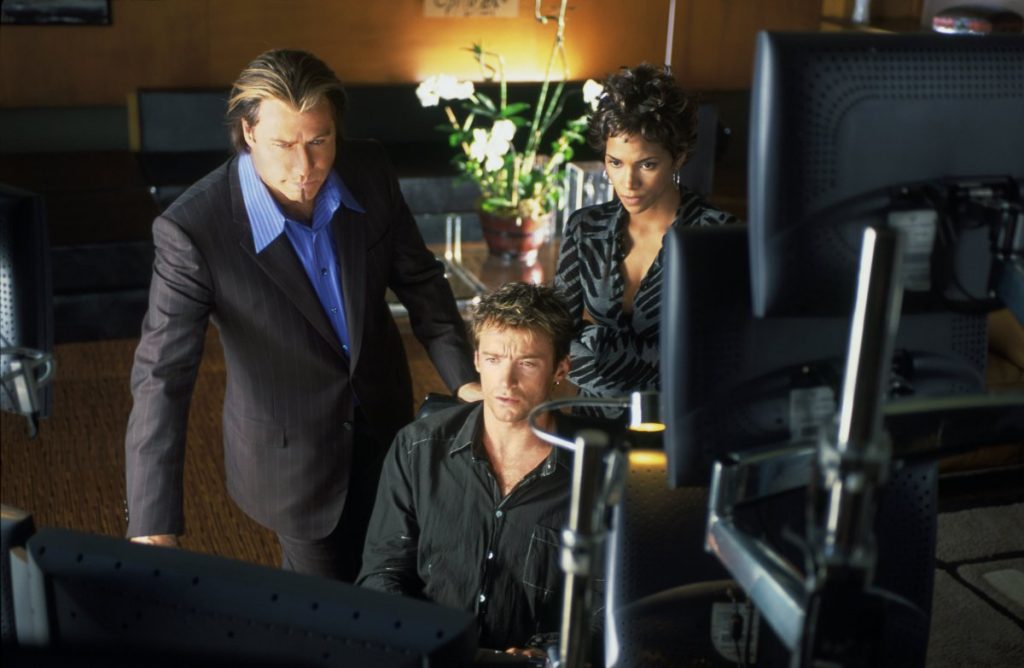The summer season is upon us, the water’s just right and all the beer stands are beckoning you for a cold one more persuasively than at any other time of the year. It’s that time of the year when the sun is up really early and goes to sleep quite late, and you’ll probably read our blog only on your phone on the way home from summer beer gardens. That’s why we’ll also ease up a little and instead of posting another technical article, we decided to write about a different, more entertaining topic that’s more suited for summer.
Hacking in Movies – Fast and Furious Typing

The 1980s
In the days when PCs were not an integral part of every household and their streamlined industrial production was only beginning, hacking had already been seen in the movies. The pinnacle of this “mainframe” era are the 70s when computers became important tools for demanding work processes. While celebrating the progress, another thought crept in: The computers are helping us but they’re still just an unknown black box that only a few geeks actually understand. Can machines become more clever than humans? Won’t they realize that they can operate themselves with no human interaction?
A few years before James Cameron found Arnold Schwarzenegger in one of the darker corners of Hollywood and introduced perhaps the most well-known computer threat to the world – Skynet, the “man vs. machine” topic was already explored by WarGames in 1983. Young Matthew Broderick (under the impression that he is playing a computer game) unintentionally starts a process that very well might escalate to become the Third World War. And the computers just refuse to understand that the process should be stopped. The command has been entered, computers have taken over, there’s no way back. Sometime during this period, the idea of hacking being something that should prevent computers from doing something catastrophic emerged. It’s a battle between the human and the machine and the grand finale for the viewer is that the human brain is still better than a synthetic one. Human hackers manage to overcome all obstacles and traps set by the computers which, when defeated, would cry their screens out, if they actually could. Instead, they just get destroyed in a spectacular explosion. Because anything that explodes looks really cool on screen.
People enjoyed it and no one cared that it didn’t make much sense. The story is set somewhere on the good – evil axes, there’s very little logic to be found, but the important thing is that evil (computers, in this case) is punished and humans can have their barbecues in peace once again.
Having the linearity and understandability of such stories in mind, the moviemakers agreed that hacking has to be fast and visual (in any case nothing else would work given the nature of movies). Movies have to look real, be entertaining and understandable even to a grandma that has not been in a cinema for ten years. Back in the day, no one cared that the difference between real-life hacking and movie hacking is colossal. There was no computer-specialized education, nothing to use for comparison, and the screenwriters were just making up most of the information. It just had to be really watchable.
This set a standard that just a very few managed to overcome in the following years. A new wave of movies arrived, showing hacking as fast-paced entertainment for young people that look dangerously cool while doing it. And we laugh at these movies. Then, the notion of hacking in movies gradually transformed into something that corresponds to reality as we know it; industrial espionage, blackmailing, extortion, stealing important information for profit, stealing money in general… But the format stayed the same – stylish, nice-looking hackers furiously typing weird things on the keyboard with the PC screen showing popups stating “Access to FBI granted” or “Uploading deadly virus” and the whole process is over in minutes. Hugh Jackman in Swordfish (2001) showed us that breaking the most complicated encryption algorithm in the world takes under a minute while John Travolta is holding a gun to your head and a hot girl is distracting you.
The 1990s
Visiting theatres in the 80s was epic. Moviemakers went nuts, giving bizarre action movies to the world which, today, would not even make it to become a rough draft of a movie script. It was a time of straightforward mainstream movies as well as crazy experiments and the clumsy hacking pictured in movies was one of the ingredients that was just right. But during the 90s, people got serious about it. The Internet was on the rise along with no-nonsense sci-fi movies, and a new wave of action heroes emerged. This included heroes that could not only carry a whole tree on one shoulder (but we still love you Arnie!), but ones that also started using their brains and the new technology. Everyone in Hollywood started playing a darker tune and the viewers began to question if what they were seeing was actually possible in real life.
Unfortunately, the portrayal of hacking in movies did not evolve much from the trend set in the 80s. Let’s take the year 1995 as a nice example of Hollywood giving us not only The Net starring Sandra Bullock, but also a movie with the confident title, Hackers. Everyone is dangerous and tech-savvy but when it comes to hacking (or uploading viruses) you see the worst possible thing you can on a movie screen. As one wise movie critic said: If hackers should have taught us hacking, I’m happy I survived the year 2000. See for yourself why it became a cult movie.
Sandra Bullock as a computer expert caught in The Net goes through a pile of animated gifs and scripted pixelated pictures the whole movie to discover a conspiracy hidden behind a weird button in a program saved on a floppy disc, resulting in all the gangsters of the world chasing her down. Everyone who had even the slightest idea what a computer is had to have laughed for the whole two hours. Sandra hides, drops funny technology trivia, hacks everything she sees, making it so stupid in the end that even the most average viewer had to shake his head in disbelief. If Sandra had not been the perfect partner to Keanu Reeves in Speed a year earlier, one could begin to worry not only about the brain tumour that watching The Net gave them but disregarding her career as well.
Fortunately, 1999 introduced us to The Matrix, which changed movie trends forever and brought hacking to the first league. The Wachowski Brothers (now sisters of course) had a vision that emerged from cyberpunk, Japanese anime, sci-fi classics from the 1950s (and everything cool that came after) and presented it in an irresistible multi-genre blend that blew our minds. In the Matrix, hacking is not a side motif, hacking is hard-core, hacking is a lifestyle, you escape reality through hacking. You break free, find your inner self and save mankind at the same time. And you do this wearing a stylish black coat and dangerously elegant glasses. Who could resist?
Matrix was clever. Instead of trying to show hacking in line with reality, it showed it through universal movie language as the transformation of a young computer geek with no friends, whose dream comes true as he peeks into the rabbit hole. He learns martial arts, slows down time during combat, finds true love and, for all of this, he just has to be curious, to feel that there’s something more to life than the usual boring routine. Doesn’t everyone have the same feeling at least once in their life?
So what’s next…?
One could think that after The Matrix, things would have gotten better. Unfortunately, hacking slid back to a position of little respect. One of the reasons might’ve been Swordfish, where you can see Hugh Jackman assembling a cube while spinning on a chair. Even Live Free or Die Hard is all about hacking, and it’s the worst thing about the movie. Justin Long runs around the city carrying an old Nokia with no data, kicking cyber-terrorist butts who have a fixed line connection and high-end computers, while Bruce Willis rants about the good old days without computers. Fast forward two years to Surrogates (starring Bruce once again), in which the main character in a hacking-induced trance keeps on yelling “Press CTRL + F7… Press CTRL + F7!” at the end of the movie, as if CTRL + F7 would be the master key for hacking any computer in the world.
The new millennium then presented the ambitious Antitrust. The scriptwriter, Howard Franklin, supported by an army of geeks tried to write a clear techno-thriller about a malicious corporation and a good programmer who sees what the corporation is really up to and puts an end to it. The opening credits as HTML tags, a lot of tech jargon, real looking code, it all suggested that we might see a good movie after all. Unfortunately, it turned out that people are not interested in a movie that’s not fast paced and doesn’t show any exploding computers. Also, the plot was not one of the better ones and thus Antitrust was quickly (and rightfully so) forgotten.
Blackhat by Michael Mann tried to get a bit closer to reality but was killed by its long runtime and slow tempo. Not many people saw Blackhat in theatres and so hacking, once again, didn’t manage to return to the mainstream. Mr. Robot, a TV Series that aired in 2015, on the other hand has received critical acclaim. Mr. Robot, a story about an outsider and his hobby – hacking – is praised by some and hated by others, but everyone agrees at least on one thing – it tries to be very realistic when it comes to computers. And it goes beyond just ones and zeroes, as far as hacking is concerned (presenting even e.g. social engineering that doesn’t appear in movies often). Mr. Robot prides itself on the fact that, during its creation, the best tech minds cooperated with screenwriters that can make the boring task of inputting commands into a console look quite dramatic.
But it’s one of the rare exceptions in the world that confirms the general rule: Considering how hacking was presented in the last three decades and that it has not improved much until the present day, we can’t expect any major improvements anytime soon. The ordinary viewer doesn’t want to get too much into hacking because it would be boring and could kill the movie outright, at least as far as its revenue is concerned. All it takes is for everything on the screen to look somewhat cool and the actors to use foreign words that sound like computer speech. So if you want to watch something more realistic, you have to turn to specialized documentaries. Fortunately, there’s always going to be enough of these. Zero Days is one of the new ones that I can recommend. It’s very entertaining and talks in depth about the infamous Stuxnet.
Anything else to say? I have fond memories of a Czech TV series called Ďáblova lest, based on a book by Arnošt Vašíček. In the last episode, Vojtěch Dyk sits at one of the computers in a public library and gets into the intranet of a company through the HTML code of the company’s website (to get some personal data he needs). My roommate, a zoologist by trade at that time, nodded with respect and said something like “What a boss.” When I asked Jiří Strach, the director of Ďáblova lest, why he didn’t make the scene better, he simply replied: “Why bother, people watching it will be happy with this.” And he was right.
Hacking in movies will always look a little funny to experts. But everything that needs a certain level of education has to be adjusted before it’s shown on screen. So we IT folks don’t have to be sad over hacking being showed in an unrealistic way. Every other sophisticated issue follows the same trend.
Let me know in the comments what your favourite movie about hacking is that I forgot to mention.





